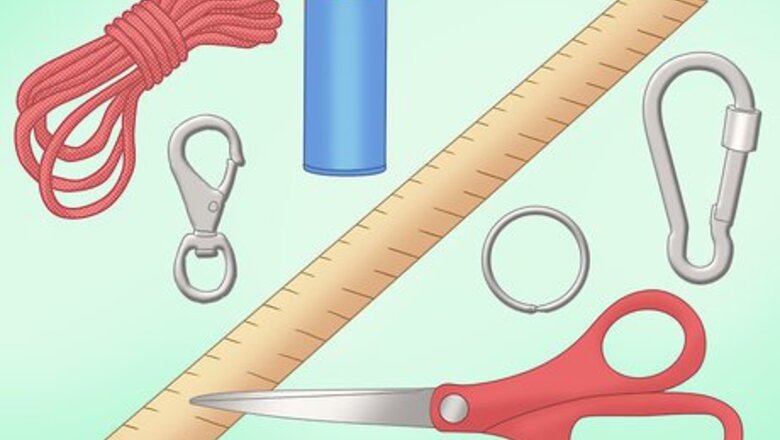
views
Setting Up The Paracord
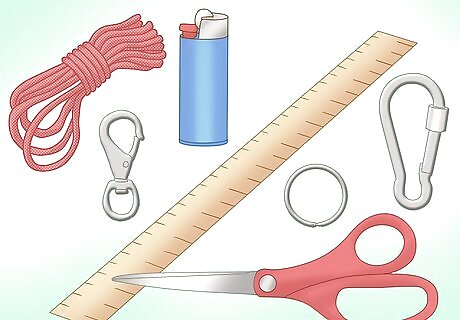
Gather your materials. To make a paracord lanyard, you will need at least 6–13 feet of paracord 550, a metal carabiner clip, snap hook, or metal key ring, a ruler or tape measure, a twist tie (or something to easily mark a the center of the cord), scissors, and a lighter. The proportions of the paracord can differ depending on how long you want your lanyard to be. For about every foot of paracord length used, you will get about an inch of your braiding knots. If you want to make a lanyard using just cobra stitching, you may only need about 6–8 feet of paracord. However, if you want to make a king cobra stitched lanyard, you may need about 13 feet. For example, 8 feet of paracord will yield about 8 inches of braiding knots for your lanyard.

Mark the center of your paracord. Fold your long, 6–13 foot paracord in half. At the top of the fold, mark the center by tying a twist tie or rubber band around the paracord. You can really use whatever kind of marker you want, just make sure that it can stay put as you make your knot, and then easily be removed.
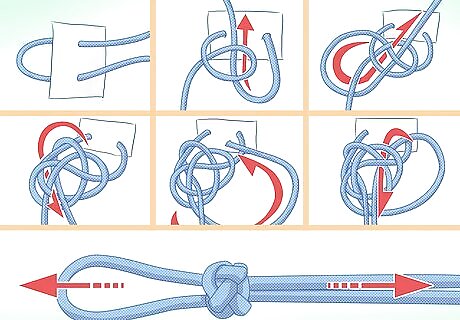
Tie a lanyard knot. If you are tying this knot for the first time, it may be beneficial to use a sheet of paper to visualize how the cords intertwine to tie the know. Poke two holes vertically, on top of each other, about 4 inches apart through the middle of the paper. Feed the loose ends of the paracord through the holes in the paper, and have the looped end of the cord on the left side of the paper, while the loose ends through the paper go off to the right. Pull the cords all the way through the paper so there is no visible loop hanging on the left side, but rather, the "loop" is flush against the paper. You will need about a two-inch loop by the time you’re finished with the knot, so having the cords pulled flush against the paper can help you achieve this. Lay the paper flat on a table. Take the paracord passing through the bottom hole of the paper, and make a loop near the paper hole. Then take the paracord passing through the top hole, and place it underneath the bottom paracord’s loop. Have the cord sit through the middle of the loop. For example, the top cord should look like a center “pupil” running through an “eyeball” (the loop). Also place the upper cord underneath the bottom loop’s tail cord. Feed the tag end of the top paracord down through the right side of the “eyeball,” underneath the “pupil,” and up through the left side of the “eyeball.” Gently pull both tails of the cords to tighten the knot just a little bit. You should have a very elaborate and mirrored knot pattern. Take the tag end of the paracord coming from the bottom of the knot, bring it around to "trace" the right of the knot, past the top hole where the other cord is coming from, and underneath all of the upper cords, to come up through the “eyeball” center. The same technique will be used for the other tag end of the paracord. Bring the upper paracord tail around to "trace" the left of the knot, past the bottom hole where the other cord is coming from, underneath all the lower cords, to come up through the “eyeball” center of the knot. Tear off the piece of paper, and hold onto the looped cord that was on the other side of the paper. Gradually pull and tug on both tag ends of the paracords while holding onto the looped cord. Make sure the looped side of the lanyard knot has about a two-inch loop. The center of the paracord (marked) should be in the middle of that two-inch loop.
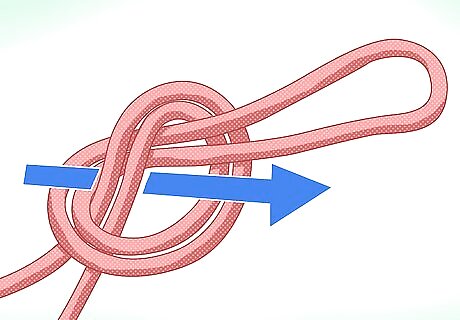
Make a simple overhand knot. If the lanyard knot seems too complicated and intricate, you can make a simple overhand knot. From the looped portion of the paracord, pinch down the paracord about 2 inches from the top of the loop. Twist the loop over the tag ends to make another larger hoop, and pull the center of the looped paracord through the middle of the larger hoop.
Braiding The Paracord
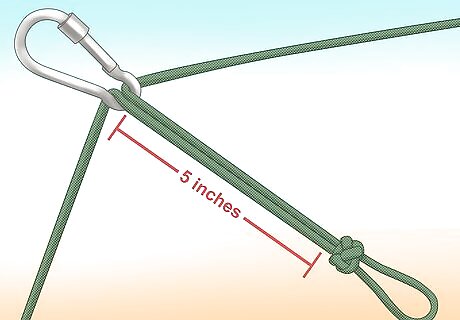
Connect the paracord to the carabiner. Feed the two loose ends of the paracord through the loop of the carabiner clip, snap hook hole, or metal key ring. Pull the ends through the loop until the lanyard knot is about 5 inches away from the base of the clip. If the snap hook hole is pretty wide, you can loop the ends of the cord around one more time, to take up more of the wide space.
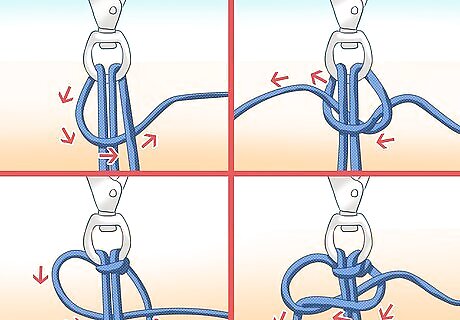
Cobra stitch the paracord. The two end sides of the paracord are the two cords you will be knotting to create the cobra stitch. You will be knotting onto the two center cords running 5 inches down from the base of the carabiner. Take the left hand paracord, and fold it to the right, over and across the two center cords. Then take the right hand paracord, and pass it on top of the tail end of the left side paracord, under the two center cords, and up through the loop created by the left hand paracord. Then pull the loose ends tight. To make the next knot, follow the same instructions, except reversed to the other side. Take the right hand paracord, and fold it to the left, across the two center cords. Then take the left hand paracord, and pass it on top of the tail end of the right side paracord, under the two center cords, and up through the loop created by the right hand paracord. Then pull the loose ends tight. As you continue to knot, you are going to alternate which side of the paracord gets crossed over the two center cords to make the first loop. For example, for the first knot, you made the loop starting with the left hand paracord. For the next knot, start the loop with the right hand paracord. For the knot after that, start the loop with the left hand paracord, and so on and so forth. Keep cobra stitching over the two center cords until you get 11 knot bumps on each side of the lanyard. If this lanyard is satisfactory to you, you can cut off the excess pieces and melt the loose ends to the rest of the paracord. However, if you want to use up the rest of your paracord, you can do a king cobra stitch.
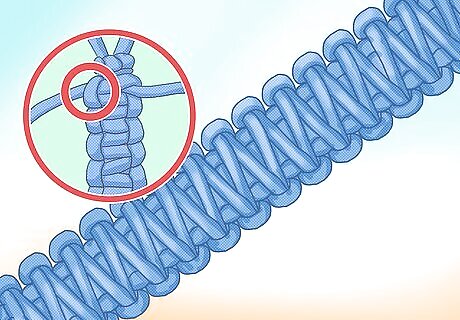
King cobra stitch the paracord. A King cobra stitch uses the same technique as a cobra stitch, it is just done on top of an existing cobra stitch, and makes the lanyard a bit thicker. Continue cobra stitching the paracords back toward the carabiner end using the same, alternating sides stitching technique you used earlier. Begin by making the first loop with the paracord that has just gone under a loop. You can tell which paracord this is by looking at the sides and seeing which paracord is coming out underneath a bump loop on the lanyard. While making the king cobra stitches, you may need to use your fingers to push the knots up toward the top to make them even. However, the king cobra stitch sides will naturally end up matching up with the spaces in between the original cobra stitches.
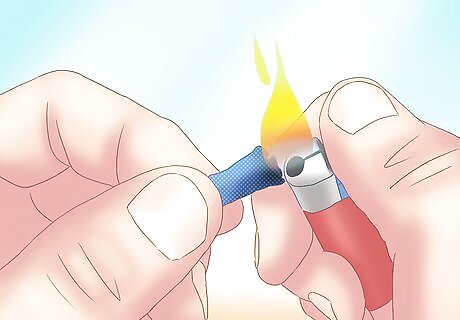
Cut and melt the loose ends. When you are finished king cobra stitching all the way back down to the end of the carabiner, cut off the loose ends of paracord. Leave about ¼-inch space on the snipped ends. Melt each snipped end with a lighter, using the lower, darker part of the flame to melt the paracord rather than burn it. After about 5-10 seconds of melting the paracord end, push the paracord against rest of the lanyard with the metal part of your lighter. This will help cool the melted paracord and connect the melted end to the rest of the lanyard. Do this same melting procedure for the other snipped end of the paracord. When both loose ends of the paracord are melted and secure, you are ready to use your paracord lanyard.



















Comments
0 comment